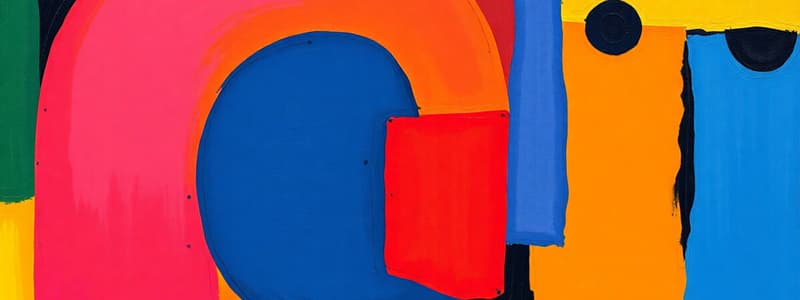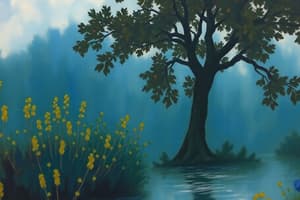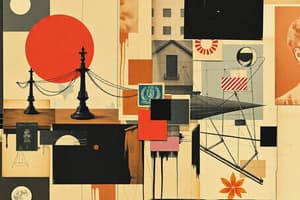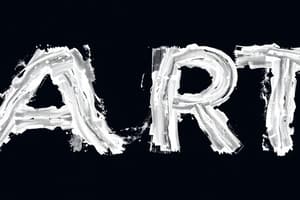Podcast
Questions and Answers
How does the element of 'space' primarily affect an artwork's composition?
How does the element of 'space' primarily affect an artwork's composition?
- By defining shapes and structures within the artwork.
- By dictating the realism and volume of three-dimensional objects.
- By influencing the relationships between objects, adding depth and perspective. (correct)
- By conveying mood and symbolism through color variations.
What distinguishes 'transcreation' from a typical art translation?
What distinguishes 'transcreation' from a typical art translation?
- It primarily focuses on correcting perceived flaws in the original artwork.
- It focuses solely on replicating the original artwork in a new medium.
- It aims to create an exact copy of the artwork without any alterations.
- It involves adapting the original artwork to resonate within a new cultural context while preserving its artistic vision. (correct)
Which factor of transcreation involves altering key aspects of the original artwork?
Which factor of transcreation involves altering key aspects of the original artwork?
- Replication
- Transformation
- Distortion (correct)
- Appropriation
How does 'transformation' influence transcreation in art?
How does 'transformation' influence transcreation in art?
In art, what does 'appropriation' specifically involve?
In art, what does 'appropriation' specifically involve?
How does the principle of 'unity' affect an artwork?
How does the principle of 'unity' affect an artwork?
What characterizes 'balance' as a principle of art?
What characterizes 'balance' as a principle of art?
What is the primary role of 'emphasis' in an artwork?
What is the primary role of 'emphasis' in an artwork?
How does 'contrast' primarily function in art?
How does 'contrast' primarily function in art?
What does 'proportion' primarily ensure within an artwork?
What does 'proportion' primarily ensure within an artwork?
What effect does 'pattern' create within an artwork?
What effect does 'pattern' create within an artwork?
How does variety serve an artwork?
How does variety serve an artwork?
What is the main function of ‘The Rule of Thirds’?
What is the main function of ‘The Rule of Thirds’?
In visual communication, what role do images, symbols, and colors play?
In visual communication, what role do images, symbols, and colors play?
What is the focus of the semiotic plane in visual communication?
What is the focus of the semiotic plane in visual communication?
What does the term 'signifier' refer to within the semiotic context?
What does the term 'signifier' refer to within the semiotic context?
In semiotics, what is the 'signified'?
In semiotics, what is the 'signified'?
According to Charles Sanders Peirce, what do 'icons' represent?
According to Charles Sanders Peirce, what do 'icons' represent?
What is the function of the 'contextual plane' in interpreting visual media?
What is the function of the 'contextual plane' in interpreting visual media?
What does the 'Primary Level (Pre-iconography)' focus on in iconographic analysis?
What does the 'Primary Level (Pre-iconography)' focus on in iconographic analysis?
Flashcards
Line (Art Element)
Line (Art Element)
Defines shapes, directs gaze, expresses movement/emotion.
Shape (Art Element)
Shape (Art Element)
Forms foundational structure, organizes elements into patterns.
Color (Art Element)
Color (Art Element)
Conveys mood, symbolism, creates emphasis in artwork.
Space (Art Element)
Space (Art Element)
Signup and view all the flashcards
Texture (Art Element)
Texture (Art Element)
Signup and view all the flashcards
Value (Art element)
Value (Art element)
Signup and view all the flashcards
Form (Art Element)
Form (Art Element)
Signup and view all the flashcards
Transcreation in Art
Transcreation in Art
Signup and view all the flashcards
Distortion in Art
Distortion in Art
Signup and view all the flashcards
Transformation (Art)
Transformation (Art)
Signup and view all the flashcards
Appropriation (Art)
Appropriation (Art)
Signup and view all the flashcards
Unity (Art Principle)
Unity (Art Principle)
Signup and view all the flashcards
Balance (Art Principle)
Balance (Art Principle)
Signup and view all the flashcards
Emphasis (Art Principle)
Emphasis (Art Principle)
Signup and view all the flashcards
Contrast (Art Principle)
Contrast (Art Principle)
Signup and view all the flashcards
Proportion (Art Principle)
Proportion (Art Principle)
Signup and view all the flashcards
Pattern (Art Principle)
Pattern (Art Principle)
Signup and view all the flashcards
Variety (Art Principle)
Variety (Art Principle)
Signup and view all the flashcards
Rule of Thirds
Rule of Thirds
Signup and view all the flashcards
Visual Communication
Visual Communication
Signup and view all the flashcards
Study Notes
The Elements of Art
- Line defines shapes and structures, directs the viewer's gaze, and expresses movement or emotion
- Shape forms the foundational structures of a piece and creates visual patterns
- Color conveys mood and symbolism, creates emphasis, and affects the visual interest of artwork
- Space affects the relationships between objects by providing depth and perspective
- Texture enhances visual interest and indicates how surfaces feel, adding a tactile dimension to artwork
- Value is the use of light and dark contrasting areas to create depth and solidity
- Form represents three-dimensional objects and lends realism to the artwork
Transcreation in Art
- Transcreation involves the creative adaptation of artwork into new cultural contexts while maintaining the original artistic vision and reshaping elements
- The Courtesan (after Eisen) by Vincent Van Gogh expresses admiration for Japanese art
- Bridge in the Rain (after Hiroshige) showcases Van Gogh’s unique style, diverging from Hiroshige’s original composition
- Transcreation highlights how historical works continue to influence and inspire contemporary designs
Factors Influencing Transcreation
- Distortion involves changing essential characteristics of the original
- Van Gogh's transformation of Hiroshige's woodblock print into a vibrant, swirling landscape showcases emotional intensity
- Transformation alters the medium or context of the original work
- Adapting Salvador Dalí’s The Persistence of Memory into 3D shifts how mediums shift experience
- Appropriation selects and reinterprets elements from existing works
- Van Gogh's reinterpretation of Eisen’s print infuses his style and keeps the themes
Principles of Art
- Guides the organization of art elements to contribute to an artwork's overall coherence
- Unity achieves cohesion where all elements work together
- Botticelli's The Birth of Venus shows unity through the arrangement of figures and colors
- Balance refers to the visual weight distribution in a composition: symmetrical, asymmetrical, or radial
- The Starry Night by Van Gogh uses asymmetrical balance to create dynamic tension
- Emphasis creates focal points through contrasting elements to capture viewer attention
- Dalí's The Persistence of Memory uses melting clocks as a focal point
- Contrast highlights the differences between elements and fosters visual interest
- Kandinsky's Composition VIII employs color and shape contrasts for dynamic composition
- Proportion defines the size relationship between elements and ensures harmony
- Da Vinci’s Vitruvian Man reflects ideal human proportions grounded in classical philosophy
- Pattern is the recurrence of elements like shapes or colors that create rhythm
- Hokusai’s The Great Wave Off Kanagawa uses stylized waves to establish pattern dominance
- Variety incorporates diverse elements to captivate and guide the viewer
- Warhol’s Campbell’s Soup Cans showcases variations in color and design
Rule of Thirds
- Divides an image into thirds, horizontally and vertically, to create focal points where the lines converge
- Still Life with Coffee Pot by Samuel Peploe aligns the table edge and the teapot's highlight to demonstrate the rule
Three Planes of Visual Communication
- Uses images, symbols, and colors to convey messages
- Visual communication enables quick interpretation and understanding
- Semiotic Plane, Iconic Plane, and Contextual Plane
Semiotic Plane
- Investigates how signs and symbols create meanings
- Semiotics: the study of signs, introduced by Ferdinand de Saussure
- Signifier refers to the tangible form, like sounds, words, or images
- Signified refers to the concept or meaning the signifier represents
- A red octagon represents the command to stop, a traffic sign example
Iconic Plane
- Focuses on the visual resemblance between signs and meanings
- Signs mimic the objects they represent
- Peirce's Three Types of Signs: Icons, Indexes, and Symbols
- Icons visually resemble their objects
- A photo of a cat represents a real cat
- A map depicts geographical locations
- Indexes are directly related to their objects via a causal or physical connection
- Smoke indicates the presence of fire
- A thermometer showing a high temperature to signify heat
- Symbols have a conventional relationship to their objects
- A red light meaning "stop" is derived from social convention
- The words "cat" and "dog" are agreed upon for the animals they represent
Contextual Plane
- Emphasizes the importance of historical, cultural, and social contexts to enrich meaning
- Artwork and advertisments
Iconographic Analysis
- Erwin Panofsky introduced a systematic approach involving three levels
- Primary Level (Pre-iconography) focuses on basic features of an artwork like composition and color
- The Last Supper by Leonardo da Vinci showcases elements like the arrangement of the apostles
- Second Level (Iconography) recognizes symbols and themes, requiring cultural knowledge
- The Last Supper is recognized as significant in Christian lore
- Third Level (Iconological Analysis) examines deeper meanings related to cultural contexts
- Design choices in The Last Supper reflect Renaissance values and ethical considerations
Studying That Suits You
Use AI to generate personalized quizzes and flashcards to suit your learning preferences.




